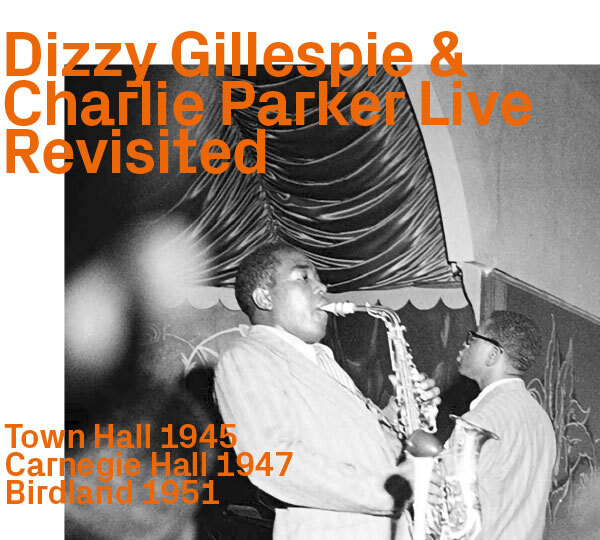What we said: In a bit of hype worthy of Symphony Sid Torin, the New York Times lauded this long-lost recording as “the Rosetta Stone of bebop.” It’s not. It is a helluva find, though. Joining Diz and Bird are Max Roach on drums, Al Haig on piano and Curley Russell on bass.
A fish-out-of-water Sid Catlett sits in for Roach on a couple of tracks, and the underrated tenor saxophonist Don Byas replaces a late-arriving Bird on the opening “Bebop.” This is basically the same band that, a month earlier, recorded four tracks that helped define the bop movement. Here they recap some of that same material in concert. While the music on this disc isn’t wildly different from the well-known recordings, it is, for the most part, terrific. The stylistic evolutionist in me is most intrigued by Bird’s break on “A Night in Tunisia.” Similar to his 1946 Dial studio version, it has a straighter 16th feel, lacking the rhythmic hiccup that made the ultimate take so mind-blowing. The performance is staid in places, but when it burns, as on “Salt Peanuts,” watch out. This has to be the record of the year–unless someone uncovers those mythical Buddy Bolden cylinders.
What we say: Our Chris Kelsey was off just a notch with his prediction–and not because those Buddy Bolden recordings popped up at the same antique store near Stamford, Conn., where these acetates were found. We suspect more of our writers heard the Monk and Coltrane CD, since Blue Note is a much larger operation than the one-man Uptown, which is run in his spare time by Dr. Robert E. Sunenblick. Plus, the sound quality of the Monk and Coltrane CD far surpasses this Gillespie and Parker find. But there’s no denying that this CD and At Carnegie Hall provided a surprising one-two punch in 2005. It’s like if Joe Lewis suddenly undied and came back still in his prime, kicking ass.
Two years ago, a revelatory suite of Charlie Parker’s recordings, made between 1945 and 1952, was released as a two-CD set, titled “Bird in L.A.” Now this collection of concert and radio performances has dropped online (on Spotify and elsewhere) and has also been reissued on vinyl. Parker is the crucial hero of modern jazz, and, in his brief life (he died at thirty-four, in 1955), he was recorded copiously by record labels in the studio—and, more importantly, he was recorded fanatically in concert, privately. It’s a sign of his preëminence that he was constantly followed by bootlegging recordists; their activity, whatever its legality, has offered incomparable treasures to the history of music and expanded Parker’s legacy.
Most of Parker’s official recordings were made in studios on 78-r.p.m. records, which maxed out at around three minutes (in the usual ten-inch series) or five (in the premium twelve-inch recordings). His live recordings—whether at Birdland, in 1950, or Rockland Palace, in 1952, or the Open Door, in 1953—are, to my mind, the ones that show how far-reaching, audacious, and boundary-breakingly advanced his music was and remains.
So it is with “Bird in L.A.” (Parker’s nickname likely came from his reputation for eating chicken, which was called “yardbird” where he was from. The prime New York jazz venue Birdland opened in 1949, barely four years after Parker cut his first records as a leader—a hint of his importance.) The recordings feature Parker in a wide range of settings and playing with a wide variety of musicians. These contexts both inflect the music itself and reveal the idiosyncratic conditions under which some of the greatest musical minds of modern times produced their singular art.
The earliest session, from December 17, 1945, is from the most classic setting: a jazz club, Billy Berg’s, where Parker, an alto saxophonist, was performing as a nominal sideman in a band led by the trumpeter Dizzy Gillespie, his prime cohort in the creation of the style known as bebop. It was an advance as significant to jazz as Abstract Expressionism was to painting. (Indeed, the two innovations developed alongside each other, in New York, in the forties.) Bebop was marked by harmonic and rhythmic complexity, defiantly difficult speeds, a tone of vehemence and fierce concentration, and an uncompromising attitude. It was danceable—people indeed danced to it, but far more often listened to it in the manner of concert music. Bebop shifted the center of jazz gravity away from big bands to small groups that were led by soloists who improvised at length. Soloists pursued their highly individualized artistry wherever they could: in jam sessions, with pickup groups assembled for the purpose of a recording or a gig, or with those already on hand as the house band at a club where they were hired.
Tracks 1-6 – rec. June 22, 1945 at Town Hall, New York:
Dizzy Gillespie – trumpet
Charlie Parker- alto saxophone
Don Byas – tenor saxophone (track 1)
Al Haig – piano
Curley Russell – double bass
Max Roach drums (track 1–4)
Sidney Catlett drums (track 5–6)
Tracks 7-11 – rec. September 29, 1947 at Carnegie Hall, New York:
Dizzy Gillespie – trumpet
Charlie Parker – alto saxophone
John Lewis – piano
Al McKibbon – double bass
Joe Harris – drums
Tracks 12-15 – rec. March 31, 1951 at Birdland, New York:
Dizzy Gillespie – trumpet
Charlie Parker – alto saxophone
Bud Powell – piano
Tommy Potter – double bass
Roy Haynes – drums
All compositions by Dizzy Gillespie, except otherwise indicated.







More Stories
CD review: George Benson – Dreams Do Come True: When George Benson Meets Robert Farnon – 2024: Video, CD cover
The band was tight as ever. The Warren Haynes Band cuts loose: Video, Photos
Interview with Alvin Queen: Feeling Good – I heard these tunes played by … Video, new CD cover, Photos